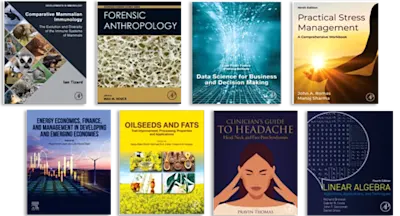
Anatomy and Physiology
- 6th Edition - August 30, 2006
- Imprint: Mosby
- Authors: Gary A. Thibodeau, Kevin T. Patton
- Language: English
A thorough introductory text on human form and function, this text presents a large, complex body of scientific knowledge in an easily understood, conversational writing style.… Read more

Purchase options

A thorough introductory text on human form and function, this text presents a large, complex body of scientific knowledge in an easily understood, conversational writing style. Focusing on concepts rather than descriptions, the text uses a “big picture” theme of body function and also explains the body’s homeostatic regulation. For the first time, every new textbook includes a downloadable e-book, which is a fully searchable, electronic version of the text plus learning resources from Anatomy & Physiology Online — with animations by body system, images, an electronic colouring book, interactive exercises, and more.
- A clear, straightforward approach and inviting reading style make it easier to comprehend the difficult subject of anatomy & physiology.
- World-class art program includes more than 1,400 full-colour photos and illustrations to enhance and simplify explanations of difficult concepts.
- Big Picture and Cycle of Life sections unify themes and help students comprehend the interrelation of body systems and how the structure and function of these change in relation to age and development.
- Dozens of unique full-colour micrographs of cellular structure enhance student learning.
- A variety of specialty boxes and tables explain the practical applications of the principles of A&P, such as the Health Matters box on “anesthetics” which explains how anesthetics produce their effects.
- Current topics (e.g., anthrax, smallpox, human genome project) are addressed in feature boxes.
- Case studies challenge students with “real-life” clinical situations.
- Health Matters and other boxes and tables explain the practical applications of the principles of A&P.
- Chapter Outlines open each chapter, giving students a short overview of subject content.
- Quick Check questions and detailed chapter summaries help students review the material.
- Content review questions help students determine how well they have mastered important concepts.
- Critical thinking questions actively engage students and challenge their reasoning skills.
- Colour-coded tabs along the side of each page differentiate the six units at a glance.
UNIT ONE The Body as a Whole
Introduction Seeing the Big Picture
1. Organization of the Body
2. The Chemical Basis of Life
3. Anatomy of Cells
4. Physiology of Cells
5. Tissues
UNIT TWO Support and Movement
6. Skin and its Appendages
7. Skeletal Tissues
8. Skeletal System
9. Articulations
10. Anatomy of the Muscular System
11. Physiology of the Muscular System
UNIT THREE Communication, Control, and Integration
12. Nervous System Cells
13. Central Nervous System
14. Peripheral Nervous System
15. Sense Organs
16. Endocrine System
UNIT FOUR Transportation and Defense
17. Blood
18. Anatomy of the Cardiovascular System
19. Physiology of the Cardiovascular System
20. Lymphatic System
21. Immune System
22. Stress
UNIT FIVE Respiration, Nutrition, and Excretion
23. Anatomy of the Respiratory System
24. Physiology of the Respiratory System
25. Anatomy of the Digestive System
26. Physiology of the Digestive System
27. Nutrition and Metabolism
28. The Urinary System
29. Fluid and Electrolyte Balance
30. Acid-Base Balance
UNIT SIX Reproduction and Development
31. Male Reproductive System
32. Female Reproductive System
33. Growth and Development
34. Genetics and Heredity
Mini-Atlas of Human Anatomy
Appendixes (Available on companion website.)
A. Metric Measurements and Their Equivalents
B. Determining the Potential Osmotic Pressure of a Solution
C. Clinical and Laboratory Values
D. Conversion Factors to International System of Units (SI Units)
E. Nobel Prize Winners in Medicine or Physiology
Glossary
Photo/Illustration Credits
Index
Introduction Seeing the Big Picture
1. Organization of the Body
2. The Chemical Basis of Life
3. Anatomy of Cells
4. Physiology of Cells
5. Tissues
UNIT TWO Support and Movement
6. Skin and its Appendages
7. Skeletal Tissues
8. Skeletal System
9. Articulations
10. Anatomy of the Muscular System
11. Physiology of the Muscular System
UNIT THREE Communication, Control, and Integration
12. Nervous System Cells
13. Central Nervous System
14. Peripheral Nervous System
15. Sense Organs
16. Endocrine System
UNIT FOUR Transportation and Defense
17. Blood
18. Anatomy of the Cardiovascular System
19. Physiology of the Cardiovascular System
20. Lymphatic System
21. Immune System
22. Stress
UNIT FIVE Respiration, Nutrition, and Excretion
23. Anatomy of the Respiratory System
24. Physiology of the Respiratory System
25. Anatomy of the Digestive System
26. Physiology of the Digestive System
27. Nutrition and Metabolism
28. The Urinary System
29. Fluid and Electrolyte Balance
30. Acid-Base Balance
UNIT SIX Reproduction and Development
31. Male Reproductive System
32. Female Reproductive System
33. Growth and Development
34. Genetics and Heredity
Mini-Atlas of Human Anatomy
Appendixes (Available on companion website.)
A. Metric Measurements and Their Equivalents
B. Determining the Potential Osmotic Pressure of a Solution
C. Clinical and Laboratory Values
D. Conversion Factors to International System of Units (SI Units)
E. Nobel Prize Winners in Medicine or Physiology
Glossary
Photo/Illustration Credits
Index
- Edition: 6
- Published: August 30, 2006
- Imprint: Mosby
- Language: English
GT
Gary A. Thibodeau
Affiliations and expertise
Chancellor Emeritus and Professor Emeritus of Biology, University of Wisconsin, River Falls, River Falls, Wisconsin, USAKP
Kevin T. Patton
Professor Emeritus Kevin T. Patton works at Life Sciences,St. Charles Community College Cottleville, MO Professor of Human Anatomy & Physiology Instruction (HAPI adjunct) Northeast College of Health Sciences Seneca Falls, NY
Affiliations and expertise
Professor Emeritus, Life Sciences, St. Charles Community College Cottleville, MO Professor of Human Anatomy and Physiology Instruction (HAPI adjunct) Northeast College of Health Sciences Seneca Falls, NY, USA